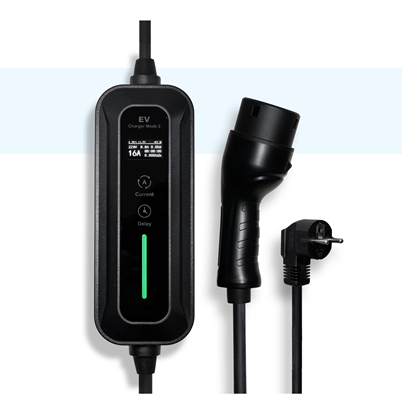From Emergency Tool to Infrastructure Asset: The Case of PlusX's Portable Charging Model in Dubai
Until recently, EV portable chargers were considered a backup solution—something to rely on when fixed charging stations weren’t available. That perception is changing rapidly.
A clear example of this shift can be seen in the United Arab Emirates. In early 2024, Dubai-based startup PlusX Electric launched the country’s first on-demand mobile EV charging service. Rather than fixed stations, the company deployed a fleet of mobile battery units delivered by a valet team, enabling users to request charging via an app and receive service on-site at homes, offices, or public parking areas.
Though different in form from plug-in portable chargers, PlusX’s model shares the core logic of portability and flexibility, responding to the same infrastructural gaps that EV portable chargers are now addressing.
Far beyond mere convenience, this marks a broader market shift. Portable EV chargers can now deliver up to 22kW. In addition, their usage and need have continued to increase as users require more flexible charging solutions, beyond the traditional charging station pin point locations.
Why Southeast Asia and the Middle East Are Prime Markets
As EV portable chargers transition from emergency tools to mainstream solutions, two regions stand out as particularly fertile ground: Southeast Asia and the Middle East. Here, EV adoption is accelerating, but charging infrastructure is struggling to keep pace—a gap that portable charger for EV is uniquely positioned to fill.
In the UAE, for example, national targets include 10,000 public charging stations by 2030 and 50% EV penetration by 2050. However, the current infrastructure is still in its early phases. Outside of central business districts, public chargers are sparse, and deployment is often delayed by permitting and planning bottlenecks.
Across Southeast Asia, countries like Thailand, Malaysia, and Indonesia are making significant investments in EV manufacturing and ownership. Yet infrastructure remains uneven, especially in suburban or industrial zones. In densely populated cities, space constraints make the installation of fixed charging stations difficult and time-consuming.
This mismatch between vehicle growth and grid readiness creates a gap—one that EV portable chargers are uniquely positioned to fill. They offer a deployable and flexible solution that helps businesses and everyday users to extend charging access reach without waiting for full-scale infrastructure to catch up.
The Growing Role of Commercial-Grade Portable Chargers
As demand for more adaptable EV infrastructure increases in these regions, a new generation of portable electric car charger is emerging, designed not only for home charging but also for and fleet operations.
Home Use Scenarios
- High convenience: Offers great ease of use for car owners, especially those without a fixed parking space or the ability to install a home charging station.
- Flexible connection: Can be connected to ordinary household power sources with no need for complex installation.
- Reduces charging trips: Enables at-home charging, minimizing the need to visit public charging stations frequently.
- Backup solution: Even for households with fixed parking spaces, EV portable chargers can serve as a reliable backup option.
- Compact and easy to store: The small size allows for easy storage without occupying much household space.
- User-friendly: Simple to operate, making it easy for all family members to use.
Commercial Use Scenarios
- Overcomes fixed station limitations: Ideal for corporate fleets (e.g., taxis, logistics, delivery services), allowing on-the-go charging in temporary locations like parking lots and job sites.
- Improves operational efficiency: Reduces downtime caused by waiting for charging, keeping fleets running smoothly.
- Supports business events: Ensures uninterrupted power supply during commercial activities and events.
- Reduces costs and boosts efficiency: Helps businesses optimize energy usage, cut costs, and enhance operational performance.
Five Key Advantages of EV Portable Chargers in Wholesale Markets
Here are five core benefits that make them a smart investment in wholesale markets:
- Mobility: Deployable anywhere vehicles operate—construction sites, logistics hubs, residential areas, or events—ideal for non-stationary or spread-out operations.
- Scalability: Unlike fixed chargers (which demand heavy upfront investment and permits), portable chargers can be distributed easily and do not require permitting.
- Speed to Market: Bypassing lengthy infrastructure timelines, they’re operational in days—enabling rapid service launches and seamless transitions for electrified fleets.
- Cost Efficiency: Portable chargers given the reduced need for permitting and lower installation costs, have a cost advantage in comparison to installed charging stations.
Key Considerations Before Deploying
Before investing in EV portable charger, businesses must assess several factors to ensure they align with regional needs and operational goals. Here’s what to prioritize:
- Compatibility: Ensure chargers match local voltage standards and plug types.
- Power output: Choose between 3.7kW EV Portable Charger and 7-22kW EV Portable Charger depending on fleet turnover requirements.
- Operational model: Consider leasing versus ownership, and whether you require support services.
- Regulatory compliance: Check local certification requirements, grid usage permits, or road safety standards for mobile units.
- Vendor support: Prioritize suppliers with local partners or service centers to ensure uptime and fast maintenance.
Conclusion: A Strategic Asset, Not a Stopgap
As EV adoption accelerates across Southeast Asia and the Middle East, the limitations of fixed infrastructure become more visible, presenting significant oppoutunities for B2B businesses to fill in the gap. EV portable chargers have stepped in—not as short-term fixes, but as strategic, long-term tools that enhance flexibility, accelerate rollout, and support sustainability goals.


